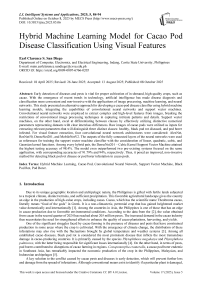Hybrid Machine Learning Model for Cacao Pod Disease Classification Using Visual Features
Автор: Earl Clarence S. San Diego
Журнал: International Journal of Intelligent Systems and Applications @ijisa
Статья в выпуске: 5 vol.17, 2025 года.
Бесплатный доступ
Early detection of diseases and pests is vital for proper cultivation of in-demand, high-quality crops, such as cacao. With the emergence of recent trends in technology, artificial intelligence has made disease diagnosis and classification more convenient and non-invasive with the applications of image processing, machine learning, and neural networks. This study presented an alternative approach for developing a cacao pod disease classifier using hybrid machine learning models, integrating the capabilities of convolutional neural networks and support vector machines. Convolutional neural networks were employed to extract complex and high-level features from images, breaking the restrictions of conventional image processing techniques in capturing intricate patterns and details. Support vector machines, on the other hand, excel at differentiating between classes by effectively utilizing distinctive numerical parameters representing datasets with clear interclass differences. Raw images of cacao pods were utilized as inputs for extracting relevant parameters that will distinguish three distinct classes: healthy, black pod rot diseased, and pod borer infested. For visual feature extraction, four convolutional neural network architectures were considered: AlexNet, ResNet50, DenseNet201, and MobileNetV2. The outputs of the fully connected layers of the neural networks were used as references for training the support vector machine classifier with the consideration of linear, quadratic, cubic, and Gaussian kernel functions. Among every hybrid pair, the DenseNet201 – Cubic Kernel Support Vector Machine attained the highest testing accuracy of 98.4%. The model even outperformed two pre-existing systems focused on the same application, with corresponding accuracies of 91.79% and 94%, respectively. Thus, it posed an improved, non-invasive method for detecting black pod rot disease or pod borer infestation in cacao pods.
Hybrid Machine Learning, Cacao Pod, Convolutional Neural Network, Support Vector Machine, Black Pod Rot, Pod Borer
Короткий адрес: https://sciup.org/15020008
IDR: 15020008 | DOI: 10.5815/ijisa.2025.05.06


